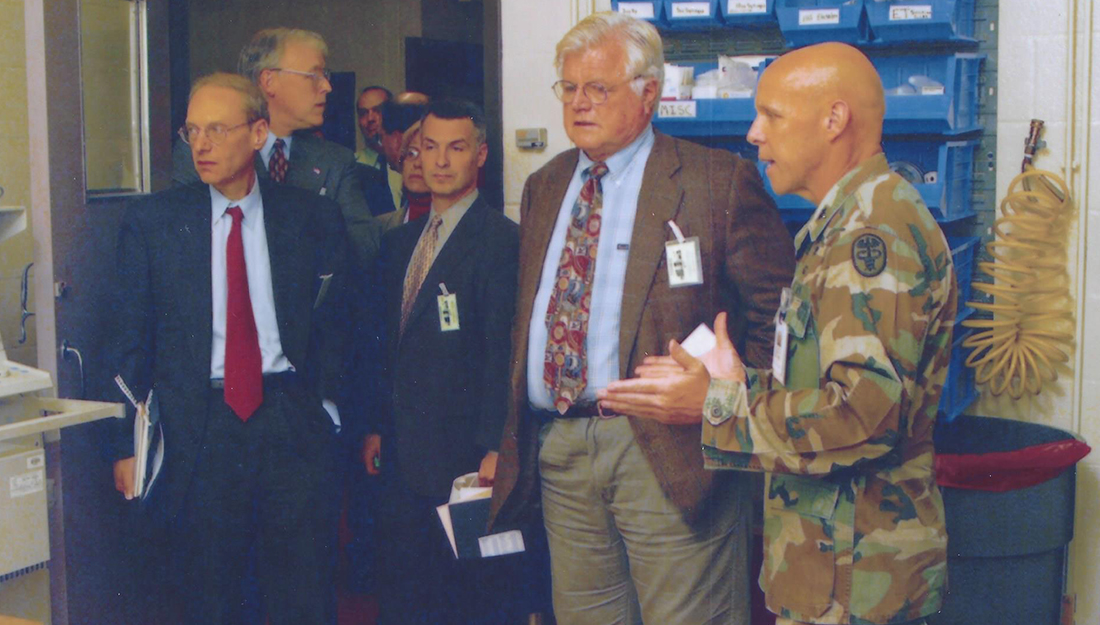- Mary Leigh Meyer
- Nursing, Show on VR homepage, Trending
From combat to classroom
LeRoy Marklund, a 30-year veteran, uses lessons learned from his career in the Army to educate tomorrow’s nurses

Army Nurse-Marklund standing next to different politicians including Senator Ted Kennedy
For nearly 15 years, a young man worked in fields of California growing almonds and pistachios. Originally a horticulture major, LeRoy Marklund, DNP, RN, now a clinical assistant professor at the Texas A&M College of Nursing, planned to become an agriculture teacher. Then one day, his dream changed. Marklund decided to become an Army nurse to both serve his country and save lives.
Lesson one: People skills
Marklund entered the Army reserves while he earned his degree in nursing. After finishing nursing school, he transitioned to active duty. “It taught me to be a leader,” Marklund said. “I learned how to work with people. You need to coach them or else they will not perform.”
He compared this lesson to the importance of educating patients on their health.
“If you only tell a patient what to do, they might not listen,” Marklund explained. “However, if you explain why they need to do something, then they will understand and be more likely to comply.”
Marklund also performed humanitarian work while in the Army. From rural Panama to the hurricane-ridden streets of North Carolina, he constantly worked to improve the health of the community.
“As an Army nurse, you do more than just nursing,” said Marklund. “Army nurses can work anywhere in the world, and in any environment. We can tackle any challenge.”
Some years, he worked as a critical care nurse going on medical missions in the heart of Afghanistan, then other years he worked stateside treating injured soldiers and veterans. “Nursing in the military constantly changes. The experience taught me how to work with people in any situation. That skill is invaluable, both as a professor and as a nurse,” Marklund said.
Lesson two: Cultural awareness
His experience also taught him the importance of cultural awareness to diversity and inclusion in health care.
In An Nasiriyah, Iraq, Marklund’s troop staged a hospital to conduct medical missions across the countryside. “We worked with Bedouin tribes that herd sheep across the Arabian Peninsula,” Marklund said. “We also worked with families. The local infrastructure was out, so they used whatever oil they could to cook. We saw a lot of burns.”
Marklund reflected how different their family culture was to his own. “They wanted to treat men first, then women and children—even if the children needed more care,” he said. “You cannot go into those situations and apply what you culturally accept, or else you will turn them away from all care.”
His troop strived to learn the culture as much as possible. “Sometimes you need to learn how you influence other people,” reflected Marklund. “We learned that in nursing school, but it is very different when you are out in the world.”
He compared this lesson to treating patients of different cultures in a hospital setting.
“If you know a little bit about different cultures as a nurse, then that knowledge will be helpful with your plan and care,” explained Marklund. “My experience in the Army taught me how to care for cultures very different from my own.”
Lesson three: Care extends past the physical treatment
“I treated many young soldiers who were seriously injured. For me, that was the hardest part,” reflected Marklund. He could not help but think of his own sons—Neil, Texas A&M class of ’18, and Lee, class of ’19.
Neil is currently a second lieutenant in the Army. “As a dad, I feel comfort knowing that there is an Army nurse somewhere that can take care of him and make sure he comes home.”
Much like his own son, most soldiers have families outside of the Army. “The importance of military care stateside, once they come home, should not be overlooked,” said Marklund. “In the field, you have them for roughly 72 hours and call it a success when they fly home. However, the care they get at home is just as important.”
When he worked stateside, many of his patients returned to active duty, but many did not. “Some veterans undergo years of rehabilitation to become fully functional again. We did everything from teach people how to drive with missing limbs to help families purchase accessible houses,” Marklund said.
The physical recovery is often not the hardest part for some veterans. “The invisible ailments like phantom pains or post-traumatic stress disorder are very real,” Marklund said. “We worked hand-in-hand with social workers and mental health professionals to take care of them. As a team, we educated at-risk veterans on the risks of opioid abuse, and connected them with appropriate resources.”
Endless drive to teach
Total, Marklund spent 30 years in the military. His last assignment was at the Carl R. Darnall Army Medical Center at Fort Hood, where he worked as the department chief for inpatient care on the ICU, behavioral health and surgery floors.
“I always loved the hands-on care that I did with the Army,” reflected Marklund. “I firmly believe any officer in the U.S. Army would make a great nursing professor, especially at the Texas A&M University Health Science Center.”
Media contact: media@tamu.edu


